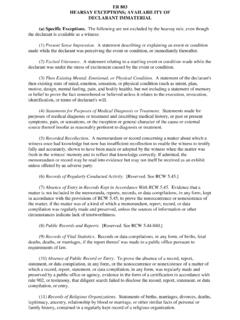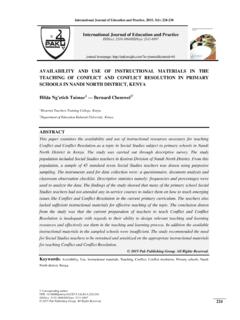Transcription of 1. Health service delivery - World Health Organization
1 Introduction and objectives of the handbook Health service delivery1 Health service delivery1. Health service delivery2 Health service deliveryHealth service IntroductionStrengthening service delivery is crucial to the achievement of the Health -related Millennium Development Goals (MDGs), which include the delivery of interventions to reduce child mortality, maternal mortality and the burden of HIV/AIDS, tuberculosis and malaria. service provision or delivery is an immediate output of the inputs into the Health system, such as the Health workforce, procurement and supplies, and financing. Increased inputs should lead to improved service delivery and enhanced access to services . Ensuring availability of Health services that meet a minimum quality standard and securing access to them are key functions of a Health monitor progress in strengthening Health service delivery , it is necessary to determine the dimensions along which progress would be measured.
2 Box sets out eight key characteristics of good service delivery in a Health system. These ideal characteristics describe the nature of the Health services that would exist in a strong Health system based on primary Health care, as set out in the 2008 World Health Report (1).The process of building evidence for the strengthening of Health service delivery must therefore proceed alongside efforts to restructure service delivery in accordance with the values reflected in Box Health sector leaders and policy-makers who are tasked with assessing their Health systems should participate in the process to deliberate on ways to assess these key characteristics in their countries.
3 Researchers should continue to experiment with methods and measures that would allow progress to be assessed over time, along these important some of the dimensions of service delivery , such as quality of care, widely accepted methods and indicators for assessment are available, although research to refine these continues. For other characteristics in the list, such as person-centredness, research and dialogue on what and how to measure it is in the early concepts that have frequently been used to measure Health services remain extremely relevant and are part of the key characteristics. For example, terms such as access, availability , utilization and coverage have often been used interchangeably to reveal whether people are receiving the services they need (2, 3).
4 Access is a broad term with varied dimensions: the comprehensive measurement of access requires a systematic assessment of the physical, economic, and socio-psychological aspects of people s ability to make use of Health services . availability is an aspect of comprehensiveness and refers to the physical presence or delivery of services that meet a minimum standard. Utilization is often defined as the quantity of Health care services used. Coverage of interventions is defined as the proportion of people who receive a specific intervention or service among those who need Health service delivery Health service delivery3 Box 1 1: Key characteristics of good service deliveryGood service delivery is a vital element of any Health system.
5 service delivery is a fundamental input to population Health status, along with other factors, including social determinants of Health . The precise Organization and content of Health services will differ from one country to another, but in any well-functioning Health system, the network of service delivery should have the following key Comprehensiveness: A comprehensive range of Health services is provided, appropriate to the needs of the target population, including preventative, curative, palliative and rehabilitative services and Health promotion Accessibility: services are directly and permanently accessible with no undue barriers of cost, language, culture, or geography.
6 Health services are close to the people, with a routine point of entry to the service network at primary care level (not at the specialist or hospital level). services may be provided in the home, the community, the workplace, or Health facilities as appropriate. 3 Coverage: service delivery is designed so that all people in a defined target population are covered, the sick and the healthy, all income groups and all social Continuity: service delivery is organized to provide an individual with continuity of care across the network of services , Health conditions, levels of care, and over the life-cycle 5 Quality: Health services are of high quality, they are effective, safe, centred on the patient s needs and given in a timely Person-centredness: services are organized around the person, not the disease or the financing.
7 Users perceive Health services to be responsive and acceptable to them. There is participation from the target population in service delivery design and assessment. People are partners in their own Health Coordination: Local area Health service networks are actively coordinated, across types of provider, types of care, levels of service delivery , and for both routine and emergency preparedness. The patient s primary care provider facilitates the route through the needed services , and works in collaboration with other levels and types of provider. Coordination also takes place with other sectors ( social services ) and partners ( community organizations).8 Accountability and efficiency: Health services are well managed so as to achieve the core elements described above with a minimum wastage of resources.
8 Managers are allocated the necessary authority to achieve planned objectives and held accountable for overall performance and results Assessment includes appropriate mechanisms for the participation of the target population and civil section of the handbook focuses particularly on the physical availability of services , which may serve as a starting point for determining methods to improve service delivery . It presents the measurement strategies and indicators for monitoring as well as the inputs , processes and outputs to the Health system as they relate to the service delivery building block (see Figure 2 in the Introduction section). service delivery monitoring has immediate relevance for the management of Health services , which distinguishes this area from other Health systems building blocks.
9 Shortage of medicines, uneven distribution of Health services , and the poor availability of equipment or guidelines must all be taken into account as part of basic service management. Health service delivery4 Health service Sources of information on Health service deliveryThere are multiple sources of data on Health service delivery . These include routine facility reporting systems, Health facility assessments (both facility censuses and surveys), and other special studies. No single method provides all the information required to assess service delivery , and multiple methods are needed to understand it completely. The strengths and limitations of the different methods are summarized in Table and discussed Health facility reporting systemA routine facility reporting system, often referred to as a Health Management Information System (HMIS), is generally used to monitor service delivery .
10 service data are generated at the facility level and include key outputs from routine reporting on the services and care offered and the treatments administered. Reporting may include supervisory or clinic-reported data on medicine stock-outs in a defined reference period ( during the last month), functioning of outreach services and availability of Health workers. Because the data are routinely collected (often monthly or quarterly), it provides information on a continuous basis for time and seasonal trend problems associated with developing service coverage estimates from facility data relate to completeness and accuracy of recording and reporting as well as biases arising from differences in use of services by different populations.













